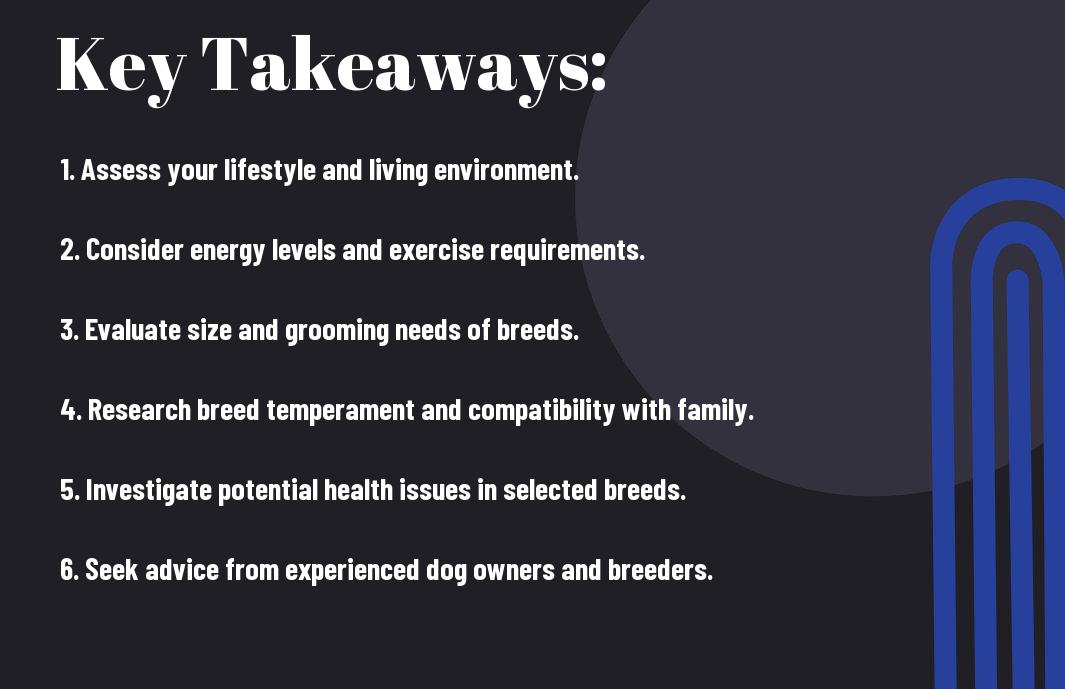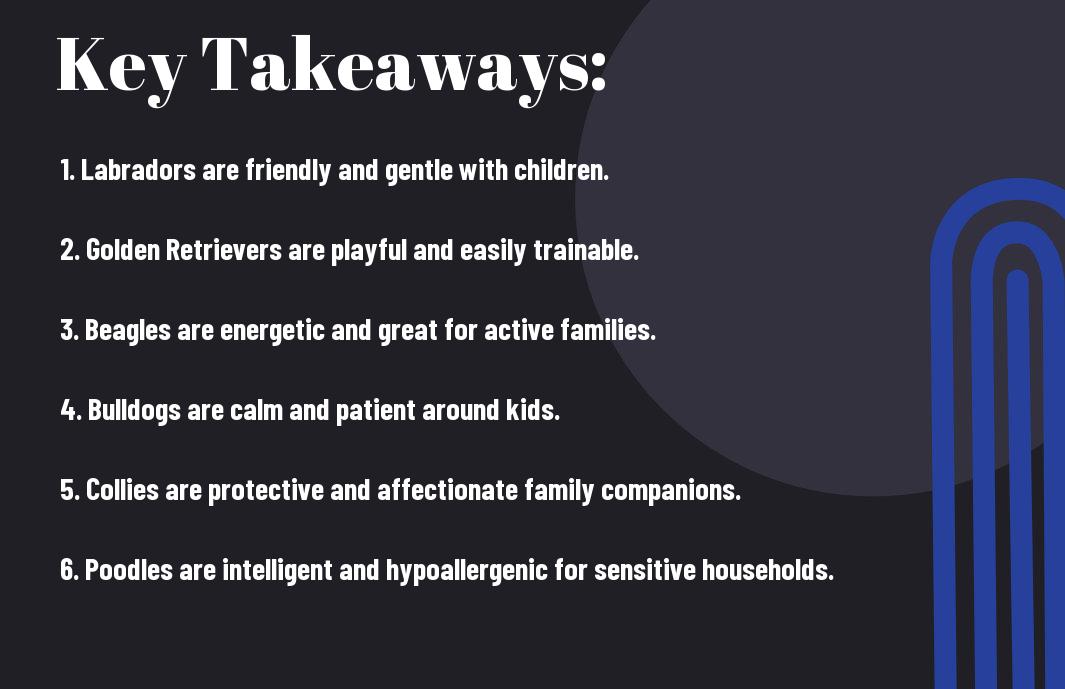Choosing the right dog breed can significantly impact your life and the life of your new pet. Understanding your lifestyle, living situation, and activity level plays a vital role in making a harmonious match. With so many breeds to choose from, each with their own unique characteristics, it’s necessary to evaluate your needs and preferences. In this blog post, you’ll discover five necessary tips that will guide you in selecting the perfect canine companion for your home and family.

Understanding Dog Breeds
To effectively choose the right dog breed for your lifestyle, it is imperative to gain a comprehensive understanding of the various breeds available. Each dog breed has its own unique characteristics, including temperament, energy levels, and grooming requirements. By familiarizing yourself with what each breed brings to the table, you can make an informed decision that aligns with your family’s dynamics and personal preferences.
The Importance of Breed Selection
After selecting a dog, the breed becomes a defining aspect of your new pet’s personality and behaviors. The importance of breed selection lies in finding a match for your living situation, lifestyle, and individual needs. Some breeds are better suited for families with young children, while others may thrive in quieter households or with active individuals who enjoy outdoor activities. Knowing your own lifestyle can help guide you in selecting a breed that will bring harmony to your home.
Furthermore, by choosing the right breed, you can help minimize behavior issues and potential frustrations that can arise from incompatibility. Some breeds may have high energy needs or specific socialization requirements, leading to challenges if they do not align with your home environment. Understanding these factors can lead to a more successful and enjoyable dog ownership experience.
The Role of Genetics in Behavior
One of the fundamental aspects of understanding dog breeds is recognizing the role of genetics in shaping behavior. Each breed has been developed for specific purposes, such as herding, guarding, or companionship. This genetic background influences behaviors, inclinations, and even certain traits that you can expect as a dog owner. For example, a Border Collie is likely to exhibit high energy and an instinct to herd, while a Bulldog may have a more laid-back demeanor.
Behavior often stems from the history and breeding practices of each dog, impacting their response to training and socialization. A breed developed for working purposes often requires mental stimulation and physical activity to maintain a balanced behavior. Understanding your dog’s genetic predispositions will allow you to provide a supportive environment catering to their needs.
Common Misconceptions About Dog Breeds
On your journey to understanding dog breeds, you may encounter various misconceptions that can cloud your judgment about specific breeds. One prevalent misconception is that certain breeds are inherently aggressive or unfriendly. In actuality, behavior is shaped by a combination of genetic predispositions, upbringing, and socialization experiences. Many so-called “aggressive breeds” can be friendly and well-adjusted if they are raised in positive environments and properly trained.
Additionally, it’s imperative to recognize that individual differences exist within every breed. Not all dogs will conform to stereotype traits, as influences like environment, training, and upbringing play significant roles. Educating yourself about the origins of these misconceptions can prevent you from making hasty decisions based solely on breed stereotypes.
In addition, understanding these misconceptions allows you to approach dog ownership with a more informed outlook. Instead of letting preconceived notions guide your choices, you can focus on assessing each dog’s individual personality and needs, thereby fostering a more fulfilling relationship with your chosen pet.
Assessing Your Lifestyle
You want to make an informed decision when choosing the right dog breed, and one of the most effective ways to do this is by assessing your lifestyle. Dogs come in a variety of breeds, each with unique needs and characteristics. Understanding your daily routine, space availability, and commitment level will greatly influence your choice.
Activity Level and Exercise Needs
Between the fast-paced lifestyles of city dwellers and the more relaxed routines of those in the suburbs, your activity level plays a significant role in selecting the right breed. Energetic breeds, such as Border Collies and Labrador Retrievers, thrive in active households, requiring frequent exercise and stimulation. Consider how much time you can dedicate to walking, playing, and engaging with your future furry companion.
Alternatively, if you prefer a more laid-back lifestyle or have limited time for exercise, you might be drawn to breeds that are less demanding in terms of physical activity, such as Bulldogs or Basset Hounds. Keep in mind that a mismatch in exercise needs can lead to issues with behavior and health, so it’s important to select a breed that aligns well with your daily life.
Space Requirements in Your Home
An imperative factor to consider is the space you have available for your new pet. Larger breeds naturally require more room to move around comfortably, while smaller breeds might do well in compact living environments. If you live in an apartment, breeds like the French Bulldog or Cavalier King Charles Spaniel may fit seamlessly into your confined space, while larger breeds like Great Danes or Siberian Huskies often fare better in homes with sprawling yards.
In addition, if you have children or other pets at home, you’ll want to think about how much space your new dog will require to interact safely with them. It’s important to evaluate not just the physical area available but also how that space will be utilized for play, relaxation, and socialization. Selecting a breed that aligns with your home’s environment is key to ensuring a harmonious living situation.
Time Commitment for Care and Training
Needs for care and training can vary significantly from one breed to another. Some dogs, like the German Shepherd or Border Collie, require a substantial amount of training and mental stimulation, along with a strong commitment from you to ensure they are well-behaved. Others, like the Shih Tzu or Pug, may require less intensive training and can adapt to a more relaxed schedule.
Ensuring that you have the necessary time to devote to training and care is vital. Dogs need consistent routines, exercise, grooming, and socialization to thrive in their environment. If you work long hours or travel frequently, choosing a breed that is more independent and adaptable can help reduce stress for both you and your pet.
Activity levels will dictate how often you need to engage in exercises such as walking, playing fetch, or providing mental challenges. Assessing your daily schedule against those commitments will help you make a choice that complements, rather than disrupts, your lifestyle.
Evaluating Temperament
All dog breeds exhibit distinct temperamental traits that can significantly influence your experience as a pet owner. It is important to understand these traits, as they determine not only the dog’s behavior but also how well it fits into your lifestyle and household. Taking the time to evaluate temperament can help ensure you choose a breed that complements your personality and family dynamics.
Profile of Different Temperaments
Across the diverse world of dog breeds, you will encounter a range of temperaments from the affectionate and gentle to the energetic and assertive. Breeds like Golden Retrievers and Labradors are known for their friendly and sociable nature, making them excellent family pets. In contrast, breeds such as the Chow Chow or Shar Pei may exhibit a more aloof disposition, requiring a different approach to training and socialization. Understanding these profiles will guide you in selecting a breed that aligns with your living situation and personal preferences.
When profiling a dog’s temperament, attributes such as playfulness, trainability, and responsiveness come into play. For instance, a Beagle’s curiosity and playful nature might be perfect for an active family that can provide plenty of exercise, while a Bulldog’s calm demeanor could better suit someone looking for a relaxed companion. Assessing these attributes will help you determine which type of furry friend is best suited for your home.
How Temperament Affects Family Dynamics
Family dynamics can be greatly influenced by the temperament of the dog you choose. A dog with a stable and calm temperament can bring more peace and harmony to a household, especially when children are involved. Alternatively, a highly energetic breed may thrive in an active household, but could create chaos in a quieter environment where calmness is preferred. Understanding how these traits play out in your family life is necessary for a harmonious relationship with your pet.
But alongside these advantages, understanding family members’ preferences and schedules can influence how well a dog adapts. A protective breed may become less tolerant in a busy household, while a shy dog might find a loud environment overwhelming. Taking time to assess how your dog’s temperament aligns with your family structure will help avoid conflicts and enhance the overall living experience, ensuring all members of the family, including your new canine companion, are happy together.
Matching Temperament with Personal Preferences
Dynamics of your lifestyle come into full play when matching a dog’s temperament to your personal preferences. If you enjoy outdoor activities and have a lot of time to dedicate to your dog, a breed known for its high energy and playfulness, such as a Border Collie or Australian Shepherd, may be ideal. Conversely, if you prefer cozy nights at home, a dog that is more laid-back and requires less physical activity, like a Basset Hound or French Bulldog, may suit you better.
Temperaments play a pivotal role in your relationship with your dog. They determine the level of training required and the type of environment you should create. Carefully considering your personal lifestyle and preferences will help you align with a breed whose temperament complements your own, making for a more fulfilling and enjoyable companionship. This thoughtful approach ultimately enhances the bond you’ll share with your new best friend.

Health Considerations
Unlike other factors, such as energy levels or grooming needs, health considerations play a significant role in your choice of dog breed. Certain breeds are predisposed to specific health issues, which can impact their quality of life and your financial investment in veterinary care. Therefore, understanding the health profiles of various breeds will help you make a well-informed decision. It’s vital to consider not only the joys of having a dog but also the responsibilities associated with their well-being and potential medical needs.
Common Health Issues by Breed
Any breed can experience a range of health problems, but some breeds are known for having particular issues that are prevalent due to their genetic makeup. For instance, large breeds like Great Danes often face hip dysplasia, which can lead to arthritis and mobility issues, while small breeds like Dachshunds can suffer from intervertebral disc disease due to their elongated spine. This highlights the importance of doing thorough research into the common health concerns tied to specific breeds before making a choice.
In addition, certain breeds may also develop hereditary diseases. For example, Boxers are known to have a higher incidence of cardiomyopathy, a serious heart condition, while Bulldogs may struggle with breathing problems due to their brachycephalic (short-nosed) structure. Being aware of these challenges allows you to prepare adequately and make a more thoughtful decision concerning your future dog’s needs.
Lifespan Expectations of Various Breeds
To consider the lifespan of a breed is vital for evaluating how much time you might spend with your new companion. Generally, smaller breeds tend to live longer than larger breeds. For example, Terriers can live 12 to 16 years on average, while giant breeds such as St. Bernards usually have a lifespan of around 8 to 10 years. Understanding these longevity patterns can influence your decision and help you align your lifestyle and preferences with the right breed.
Understanding lifespan expectations is more than mere curiosity; it helps you prepare for both the joy and the heartache that come with dog ownership. Opting for a breed with a shorter lifespan may mean you’ll need to cope with the loss sooner than with breeds that enjoy longer lives. Additionally, this aspect may affect future decisions, such as adopting another pet or adjusting your lifestyle as your dog ages. The knowledge you gain will serve you in various stages of dog ownership.
Importance of Regular Veterinary Care
Below this vital knowledge, consider that all dogs, regardless of breed, need regular veterinary care to maintain their health. Routine check-ups, vaccinations, and preventive care are vital for identifying health issues early on and ensuring your pet has a long, healthy life. This ongoing relationship with your veterinarian not only keeps your dog in peak condition but also empowers you with experience and knowledge about healthy habits you can adopt at home.
A proactive approach to your dog’s health will help you navigate any breed-specific challenges that may arise. By investing time and resources in veterinary care, you’ll form a strong partnership with your vet, which can lead to better health outcomes and a happier life for your furry friend. Prioritizing this aspect of dog ownership brings peace of mind and ensures you’re equipped to provide the best care possible.

Size and Space Requirements
Many potential dog owners overlook the importance of size and space when choosing the right breed for their lifestyles. Your living situation, whether it be a cozy apartment in the city or a sprawling home in the suburbs, will significantly impact your dog’s happiness and health. This chapter will guide you through understanding how size can affect various aspects of dog ownership, helping you to make a well-informed decision.
Small vs. Large Breeds
Breeds come in a vast range of sizes, each with unique characteristics and needs. Small breeds, such as Chihuahuas and Pomeranians, often require less space and can thrive in apartments or smaller homes. Conversely, large breeds like Great Danes or St. Bernards need more space to move comfortably and may struggle in confined living areas. It’s important to consider not only your current living conditions but also your long-term plans, as having a dog that doesn’t quite fit in can lead to stress for both you and your pet.
When choosing a breed, reflect on any constraints your space may impose. A small dog might be ideal if you live in an apartment, but if you have a yard or live in a home with ample outdoor space, a larger breed could be a rewarding choice. Evaluate how your dog’s size will integrate into your lifestyle and the environment you provide.
Impact of Size on Daily Life
Life with a dog of any size brings joy and companionship, but the impact of your dog’s size on your daily routines can vary widely. Smaller breeds often adapt well to indoor living and require less time for exercise, which can fit seamlessly into busy schedules. In contrast, larger breeds typically have greater exercise and socialization needs and might require more committed time from you throughout the day. If you favor outdoor activities, a larger breed may be a better match for your lifestyle.
To maintain a happy and healthy relationship with your pet, consider how integrating their size into your daily life can create an enriching environment for both of you. Dogs enrich your life, but managing their needs effectively will lead to a better bond and a more harmonious household.
Exercise Needs Related to Size
Related to size are the exercise needs that come with each breed. Generally, larger dogs require more vigorous activity to stay healthy and energized, while small breeds may require less strenuous, shorter bursts of play. However, this can vary based on the individual dog’s energy level and temperament as well. For example, a small dog with a high energy level might be able to keep up with larger breeds during active playtime, while a larger, mellow dog might prefer lounging around. Tailoring exercise routines to fit your dog’s size will ensure they receive the physical activity they require.
Needs for exercise differ across breeds, so make sure to assess how much time you can realistically dedicate to your dog’s physical activity. Larger dogs may thrive in a home where regular outdoor space is available for them to roam and explore, while small dogs might meet their exercise needs with short walks around the block or half-hour indoor play sessions. Understanding and meeting your dog’s exercise needs can prevent undesirable behavioral issues that arise from pent-up energy and lack of stimulation.
Researching Breeders and Adoption Options
Once again, when you make the decision to bring a dog into your life, it’s important to do your homework. Finding the right source is just as important as choosing the right breed. Whether you opt for a reputable breeder or consider adopting from a shelter, understanding your options will significantly impact your experience. You want a healthy, well-adjusted pup, and that often starts with where you get your dog.
Finding Reputable Breeders
By conducting thorough research, you can identify reputable breeders who prioritize the health and temperament of their dogs. Start by seeking out recommendations from veterinarians or breed clubs. Make sure to visit the kennel in person to observe the living conditions and how the dogs are treated. A legitimate breeder will be open to discussing their breeding practices, health testing, and the temperament of their dogs. Look for breeders who focus on responsible breeding practices, as these will ensure you are adopting a dog that is less likely to face genetic issues later in life.
Additionally, ask about the socialization practices the breeder employs. Healthy pups should have been properly socialized with different people, pets, and environments before coming to your home. This preparation can help ease the transition for your new furry friend, promoting a smoother adjustment process. If a breeder is unwilling to answer your questions or show you their facilities, it’s a bright red flag to consider.
The Benefits of Adoption
Any time you consider adoption, you not only give a dog a second chance at life but also help reduce the overwhelming number of pets in shelters. Adoption can often be a more affordable option than purchasing a puppy from a breeder, as adoption fees usually cover initial vaccinations, spaying or neutering, and sometimes even microchips. Furthermore, shelter dogs often come with a history of their behavior, which makes it easier to find a dog that fits your lifestyle.
Understanding the various benefits of adoption can lead to a rewarding experience for both you and your new pet. When you choose to adopt, you are not just saving a life; you are also welcoming a companion who might be eager to provide you with unconditional love and loyalty. Shelters frequently have a wide range of ages, sizes, and temperaments, allowing you to find the perfect fit for your family.
Questions to Ask Before Bringing a Dog Home
Behind every successful pet adoption or purchase, lies a series of important questions you should ask yourself and the seller or adoption agency. Understanding your new dog’s background, health history, and temperament can save you and your future pet from potential issues. Ask about any medical concerns, behavioral traits, and the dog’s past experiences with people and other pets. This information is vital to ensuring a good match for your household.
Plus, consider inquiring about any training resources or support that may be available as you bring your new pup home. Questions surrounding dietary needs, exercise requirements, and any socialization practices can also provide valuable insights into what to expect as you explore dog parenting. Strong communication with your breeder or adoption agency is key to a successful integration of your new furry friend into your life.
To Wrap Up
So, when it comes to choosing the right dog breed for your home and lifestyle, careful consideration is necessary. By assessing your living situation, activity level, grooming needs, and any specific breed characteristics that appeal to you, you can make an informed decision that leads to a happy and harmonious relationship with your new furry companion. It’s important to reflect on how much time and energy you can dedicate to training and socializing your dog as well. Understanding your own personal preferences and requirements will guide you in selecting a breed that not only fits into your life but enhances it as well.
To put it briefly, the right dog breed can bring immense joy and companionship into your life, so take the time you need to explore your options. Research various breeds, talk to current dog owners, and perhaps even visit reputable breeders or rescues. By equipping yourself with knowledge and understanding, you’ll be better positioned to choose a dog that matches your lifestyle and personality, ensuring a wonderful partnership for years to come.
Q: What factors should I consider when choosing a dog breed for my lifestyle?
A: When opting for a dog breed, it’s important to assess your lifestyle and living conditions. Consider your activity level, the size of your home, and whether you have a yard or access to open spaces. Some breeds require more exercise and mental stimulation than others. Additionally, think about how much time you can dedicate to training and grooming. Families with young children might prefer breeds known for their patience, while singles or couples might opt for smaller, more low-maintenance breeds.
Q: How can I research dog breeds to find the right fit for me?
A: To effectively research dog breeds, utilize a variety of resources such as breed-specific websites, reputable dog forums, and books written by canine experts. Visiting local shelters and breed rescues can also provide insight into different breeds and their personalities. Attend dog shows or community events where you can interact with different breeds. Speaking to dog owners and trainers can offer personal experiences and practical advice regarding the behavior and care needs of specific breeds.
Q: Are there any health considerations I should keep in mind when selecting a breed?
A: Yes, health considerations are key when choosing a dog breed. It’s vital to research common health issues associated with specific breeds, such as hip dysplasia, heart problems, or respiratory issues. Some purebred dogs are more prone to genetic health issues, so consider adopting from reputable breeders who conduct health screenings. Moreover, mixed breed dogs can often have fewer inherited health conditions, so exploring local shelters might provide healthier options. Always consult with a veterinarian for guidance on which breeds may be better suited for your home environment and lifestyle.










